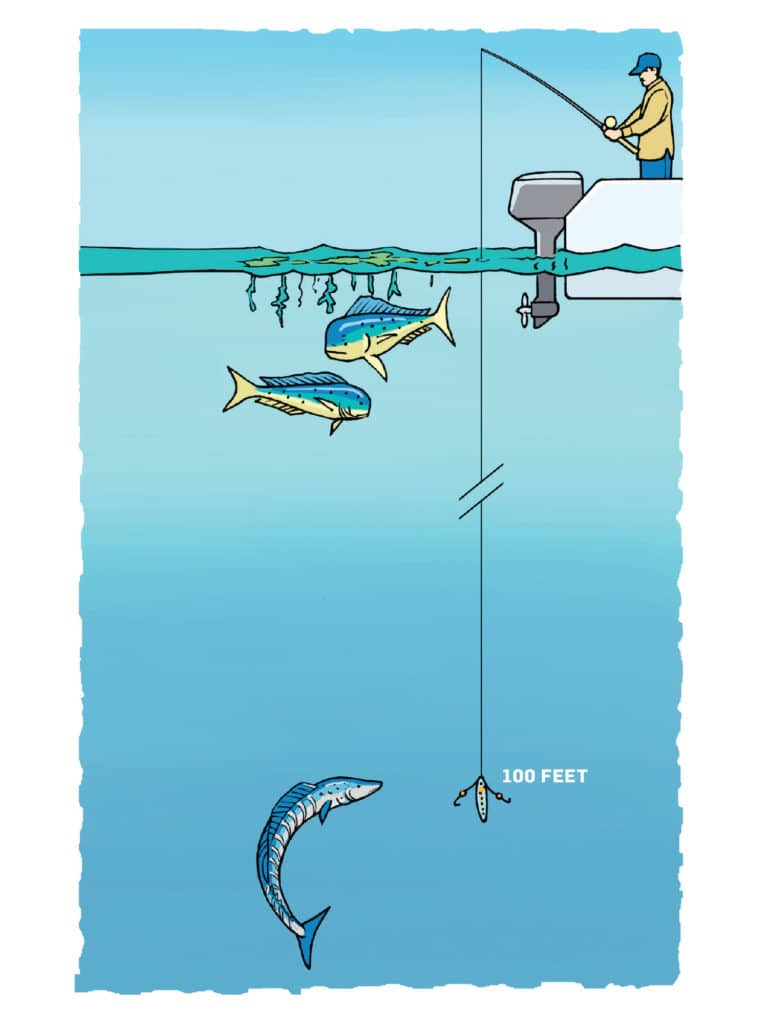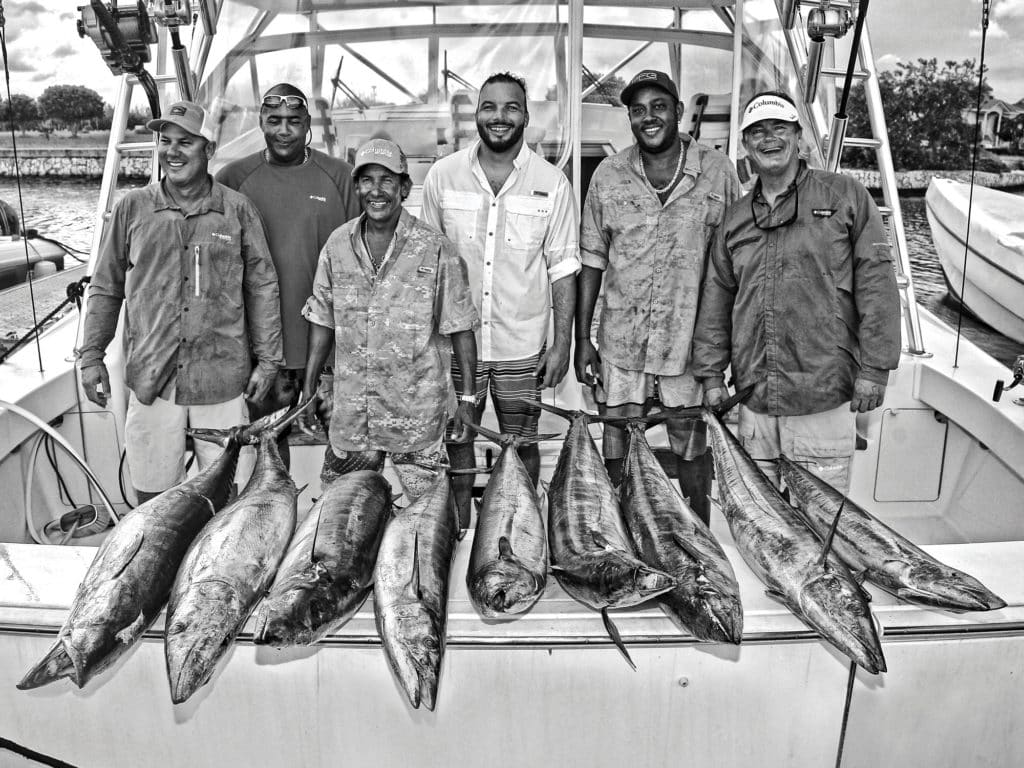
Man the torpedoes
Several hours after leaving the dock at Grand Cayman, Capt. Charles Ebanks eased off the throttles a half-mile from Pickle Bank, where the bottom of the deep Caribbean rises to 180 feet from the surface. We arrived right before daybreak, a prime feeding period, and were trolling within minutes. As soon as the sun appeared on the horizon, the first reel screamed, and then a second, a third, a fourth and a fifth.
Our trip coincided with peak wahoo time in the Caymans, and before the sun rose entirely above the water, we’d hooked five fish, boating three beauties and losing two that shook free during the fight.
Timing Is Key
Wherever you chase wahoo — off the Carolinas, South Florida, the Bahamas, the Gulf of Mexico, Southern California or elsewhere — there are peak periods on which to capitalize. For instance, major feeding occurs from just prior to sunrise to early post-dawn. “Wahoo go wild during this time. The bite might last only 30 to 45 minutes, but it’s aggressive as hell,” Ebanks claims, which is why we ran the 84 miles from Grand Cayman in the dark to reach the bank before sunrise.
The moon plays a role too. We scheduled our trip around the November full moon, in a repeat of my last visit to the Caymans, five years prior, when marine artist Carey Chen and I scored 15 wahoo, 10 of which hit between 6:30 and 8:30 a.m. By the way, my largest wahoo to date is a 143-pound monster caught off San Salvador, Bahamas, one of five wahoo we caught during a half-day of fishing on a full moon. Ebanks says the full moon is OK, but the few days leading up to it and the few days coming off it are best.
Prime Tides
Even way offshore, where tides seem insignificant, there’s still something about a transition period that triggers a wahoo bite, so it pays to know when such periods will occur. Tides are especially crucial when fishing for wahoo close to shore, as in the Bahamas, where Capt. Ron Schatman, the undisputed wahoo king, says the tides trigger their feeding. “You can pull up and down your best stretch of wahoo bottom for hours and not get bit,” he says. “Fish there prior to and into a tide change, and it’ll be a different story. I can’t tell you how many Bahamas wahoo tournaments we’ve won by fishing the tides.”
Under stable weather, explains Schatman, lack of action during an early-morning falling tide usually means a good bite during the afternoon incoming tide, and vice versa. He’s also had times when wahoo bit on all tides, but his anglers often post double-digit numbers during a tide, and once the bite ceases, he moves a little deeper and bides time trolling until they reach another area, sometimes as far as 40 miles away, to fish a later tidal change and crush the wahoo again.
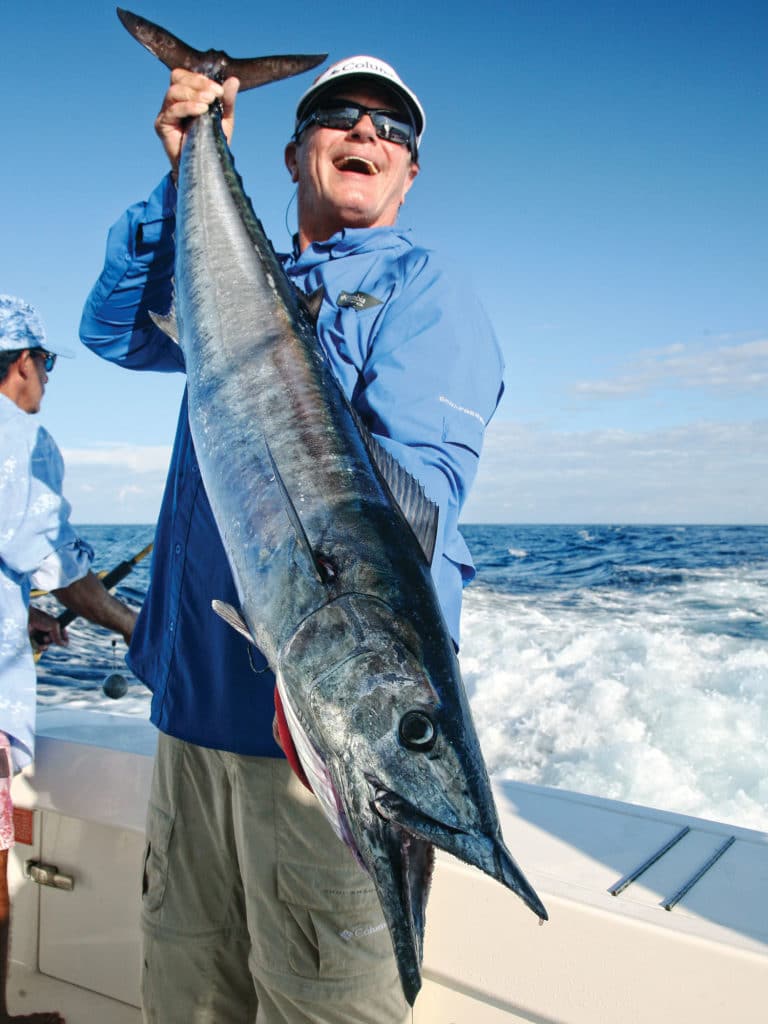
Sharp Stuff
Falling Barometer
Capt. Ben Sharpe, who spends considerable time in the Bahamas fishing for marlin and wahoo aboard the 66-foot Viking Man-E-War, says pressure changes are important markers for wahoo. “When barometric pressure begins dropping, like before a cold front or a storm, it triggers a bite,” he says. “Once the pressure shoots up, as it does once a front arrives, the fish shut down. It could take just a couple of hours or a few days for them to resume feeding; that depends on the severity of the front.”
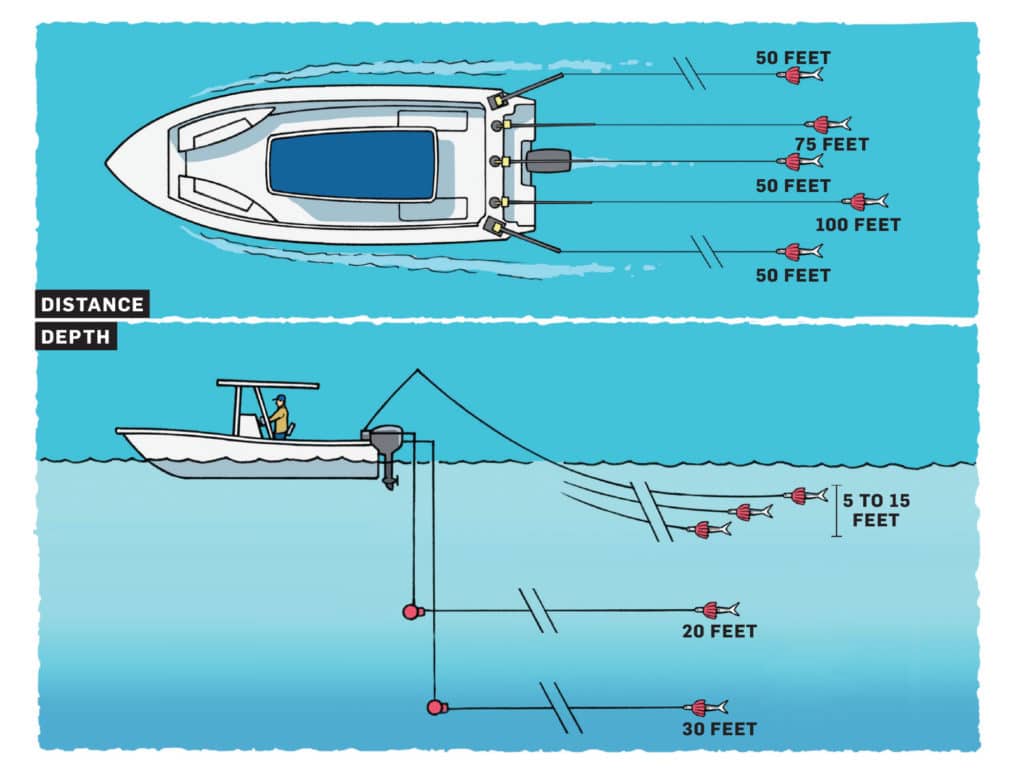
Killer Wahoo Spread
Where They Lurk
Wahoo are primarily structure-oriented fish that favor aggressive bottom formations, pronounced ledges, wrecks, rips and color changes between 90 and 350 feet of water. Nevertheless, they also stack up underneath floating debris and weed lines — often in waters well beyond 1,000 feet deep — rich with bait, and even beneath schoolie dolphin, which they prey upon.
Flutter jigs are ideal for dropping underneath floating debris. Rather than work the jig radically, I wind fast to keep it racing straight to the surface. Of course, wahoo bite through most assist-hook cords on flutter jigs, so I replace them with 50-pound titanium wire, which holds up to wahoo’s sharp dentures, is small in diameter and, compared with single-strand wire, is impervious to kinking. I also add a few inches of titanium wire above the jig to prevent cutoffs.
Dropping a live goggle-eye, pilchard, herring, blue runner or even a chunk of bonito, if liveys aren’t available, with 15 inches of 40-pound titanium wire leader and a 10-ounce egg sinker secured some 30 feet up the line with a rubber band, breakaway-style, is also effective.
A third option is to troll two jet-head lures in 16- and 32-ounce weights, or deep-diving swimming plugs like Rapala’s CD 18 around the find, ensuring one goes at least 20 feet deep. I recall running back from Bimini once and scoring five wahoo trolling a pair of lures around a large tree drifting in the Gulf Stream.
The trick to consistent action is locating where wahoo are stacking along a structure. Sharpe swears by areas where the wind or current pushes water hard against a shelf, wreck or bank. Always mark the spot where a fish is hooked so you can return and make repeated passes. The same principle applies when fishing along a reef, ledge or other bottom structure.
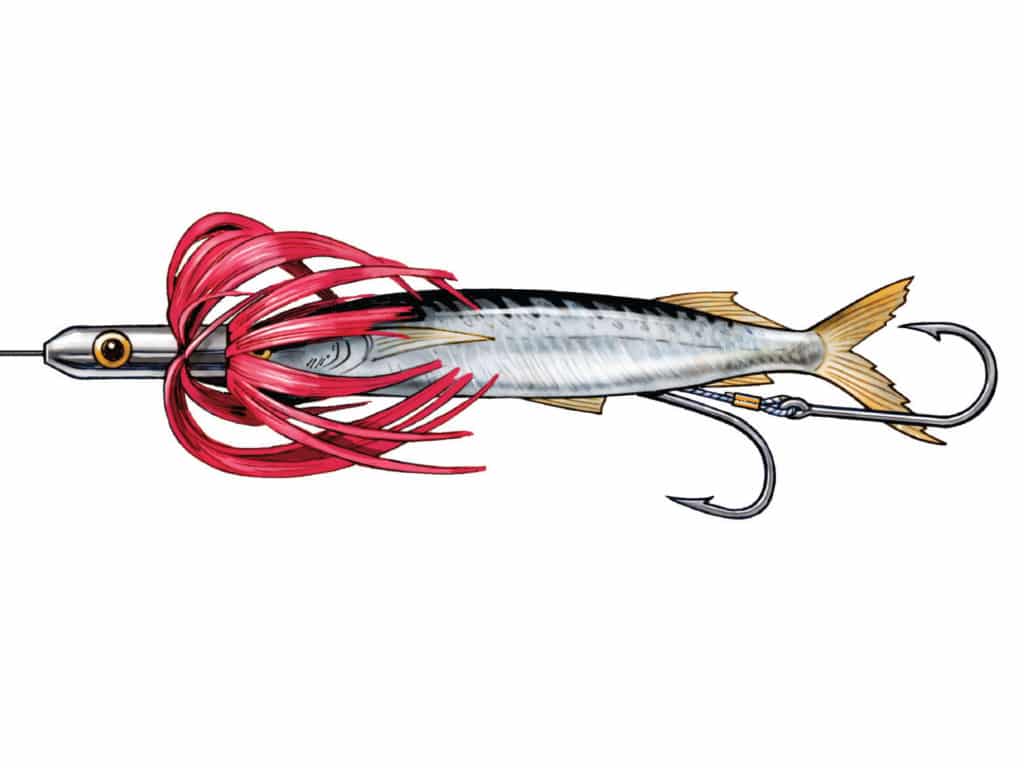
Depth and Speed
For wahoo, a lure trolled anywhere from 5 to 15 feet down is far more productive than one trolled at the surface. Subsurface lures and baits trolled rapidly yield more strikes. Although high-speed trolling (upward of 20 knots) is popular for wahoo, many are caught near the 10-knot range.
Our Cayman Islands wahoo spread was simple yet effective: Ilander lures rigged with ballyhoo on No. 12 single-strand wire (dubbed the Cayman Crusher; for rigging instructions, see saltwatersportsman.com/rigging-cayman-crusher). The hooks were 10/0, rigged to 480-pound cable, with one hook protruding from each bait’s vent, and a stinger extending just beyond the tail. These rigs miss few short-strikers, and the fluttering from the trailing hook creates fish-attracting vibrations.
The starboard downrigger took one bait 20 feet deep, whereas a portside wire-line outfit positioned another bait 30 feet down. The remaining baits were pulled just underneath the surface or several feet below, held at depth with the aid of trolling sinkers.
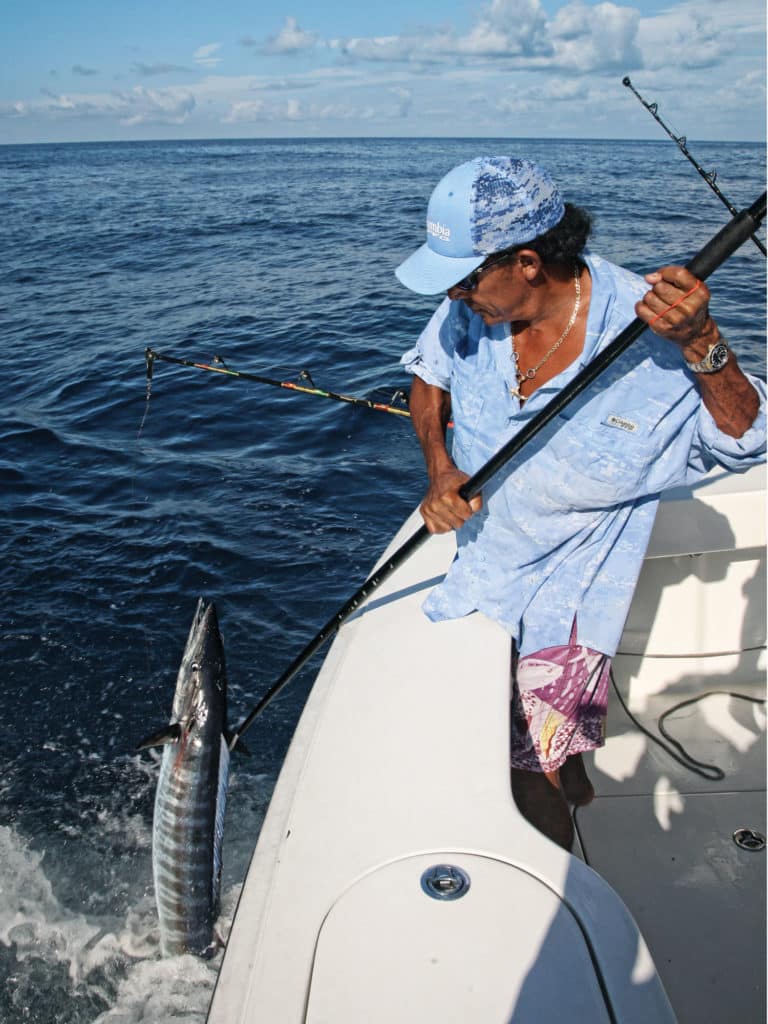
Straight up
In for the Landing
Wahoo have tough mouths, so keep the boat moving at the same trolling speed when one strikes to help drive in the hook and entice additional hookups. Avoiding slack is vital to keeping the hooks lodged, so once a fish is hooked, the captain should help the angler keep tight by bumping the boat in and out of gear. Ebanks did that on all our catches, which also helped plane the fish to the surface. Once a wahoo’s head breaks water, step up the cranking to keep it on top, where the lack of water flowing past the gills exhausts the fish quickly. A two-speed reel in high gear is ideal for the task.
Don’t slow the boat or alter its direction; just keep the wahoo coming. Even if the fish is beneath the surface, it will swim in rhythm with the moving boat and cranking pressure. Wind the wahoo steadily into range of the gaff. Once it is stuck, back off the drag and allow the gaffer to lift the fish over the gunwales and deposit it right into the fish box. When landing multiple wahoo in succession, stack each headfirst in a far corner of the boat — away from legs and feet. After the last one is boated, transfer them all into the box.
